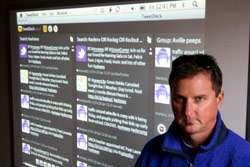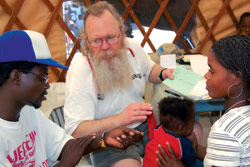Tuesday, Jan. 12: just another day in Asheville until my cell phone rumbled to life with the news of the earthquake in Haiti.
By hook or by taxi
In the midst of all of the tweeting, we still had staff unaccounted for, five days post-quake — not at all encouraging. E-mails weren't being returned, phones were unreliable at best, and even texting yielded no results. A Twitter contact had passed through Montrouis two days after the earthquake and reported to me that all was relatively well, but I was still concerned.

Later that night, I was at a dinner party in Fairview when my phone rang. It was a call from a Twitter contact who had a Haitian-American on the line whose mother was in one of the clinics in Montrouis with two broken legs. That facility has no means to treat broken bones, so she needed to get to the hospital in St. Marc, an hour up the road. I needed to find Eddy Prophete, our unaccounted-for director of operations in Haiti — and fast.
No sooner had I hung up than my connection to Haiti — my iPhone — started buzzing, and texts from Eddy began pouring in from three different numbers, none of them the one I'd previously used to contact him. I quickly advised Eddy of the situation, authorized funds to transport the woman, and — after 12 hours of various very Haitian negotiations — she was in a "tap-tap" (primitive taxi) on her way to St. Marc. Unfortunately, I also knew through Twitter that 900 people were already awaiting surgery there …
— T.K.
I'm the board chair for Mission Manna, an Asheville-based nonprofit working to end the ravages of malnutrition in Haiti, specifically in Montrouis and the surrounding area. The news struck me hard, taking my breath away. Initially, I was at a loss as to what to do. I wanted to be helping out in Haiti, but that wasn't possible, so I needed to find another way to channel my energy.
I'm in nearly daily contact with our staff in Haiti, mainly via e-mail, so I sat down at my desk to see if there was any good news. Nothing. Like many other NGOs, Mission Manna is also active on Twitter, exchanging information and ideas on a daily basis, so that's where I turned next. Little did I know the kind of journey I was about to begin.
As I'd hoped, my Twitter contacts on the ground in Haiti (many of whom are associated with major relief organizations such as Doctors Without Borders, the Red Cross and Partners in Health) immediately provided a wealth of information. As fast as I could, I retweeted their accounts of what was happening in and around Port-au-Prince as the hours disappeared into night.
Recalling that I still had no direct information from our staff in Montrouis, two hours east of Haiti's capital, I again checked my e-mail, hoping for news. There was nothing from our colleagues and friends but, notably, my mailbox was full of new Twitter followers, mainly major news outlets from around the globe. Twitter was where the information was, and somehow, they'd found Mission Manna. The link between Asheville and Haiti proved more solid than I could have known.
Follow the leaders
For those unfamiliar with Twitter, the idea is to "follow" people and groups with whom you share a common interest. If you follow someone, you see their "tweets" (messages); if they follow you, they also see your tweets (of 140 characters or less: Brevity is indeed the soul of Twitter). If someone you follow doesn't follow you, they're not aware of your Twitter posts unless you specifically mention them. So the more followers you have on Twitter, the more broadly your message will be shared.
Papa Noël has the dough
Mission Manna funds its program several months in advance, so under normal circumstances, we'd have plenty of time to wire money from Asheville to Haiti. But these were hardly normal circumstances, and after the earthquake, we badly needed to get funds to Montrouis.

Banks were closed, Western Union was closed, and I was at a loss as to how to get it done. Then a text arrived from one of our doctors, Brevard resident Ora Wells, saying he would soon be en route to the Dominican Republic, from where he'd go overland to Haiti. Bingo!
Now all I had to do was get the money in his pocket and halfway across Haiti to Eddy in Montrouis. Pa gen pwoblem … Kate Lalor, one of the many selfless volunteers on the Mission Manna board, transported the needed cash to Brevard, where Ora stuffed it deep into his pockets, probably saying a few prayers as he headed for the airport.
Many, many garbled and confused text messages later, Eddy had dispatched his cousin to meet Ora (who, due to his white beard, is known in Haiti as "Papa Noël") in Leogane. Meanwhile, Eddy jumped on his Mission Manna dirt bike and screamed toward Port-au-Prince, where he met his cousin and took possession of the money, then turned back to Montrouis and raced home in the fading daylight. As I said, pa gen pwoblem …
— T.K.
This worked to Mission Manna's advantage, as we had many Haitian Twitter users who had good information but not many followers. Mission Manna had around 700 followers at the time, many well-connected with aid organizations working in Haiti, so the synergy was there for us to be helpful. We could receive information from Haiti and disseminate it to a much wider audience than our friends in Haiti could. And in the process, we could share the experience with Western North Carolina.
The importance of this broader connection didn't dawn on me right away, but I returned to Twitter, posting what I knew before finally heading for bed, weary from the process and the day's dreadful news.
The next morning, I was shocked to see the number of new followers Mission Manna had acquired overnight: We now had nearly 1,000, all told, and they weren't just the usual spammers. Instead, it was a nice mix of locals, worldwide news groups, fellow NGOs and, surprisingly, more people on the ground in Haiti. Reading the tweets that had come in overnight, I was taken aback by the gravity of the news I'd been entrusted to retweet:
"@MissionMANNA MARTINE PIERRE SENDING MSGS! SHE's ALIVE UNDER RUBBLE @ UNIVERSITE CARAIBES #loc DELMAS 29 students alive #Haiti #rescue"
"@MissionMANNA: Greek Rescue Team Confirms There'sPeople ALIVE @ Rue Centre Building Napolin. THEY NEED BACK UP. #haiti"
"@missionmanna -community hospital in need of at least 100 packets(liter) of O neg. blood. please help"
"@MissionMANNA: 2 more survivors reported alive in a school corner Canapé Vert… more detail to come. #Haiti"
"@MissionMANNA Hospital Sacre Coeur Milot 904-223-7233 904-223-7233: full-svs 2ORs, trauma & ortho team waiting 4 patients RT"
Suddenly it all made sense: With the Red Cross and others watching our Twitter feed for clues, Mission Manna could make a difference, even from faraway Asheville. For the next 10 days, this concept became the focus of my every available minute — and it continues to do so now as relief efforts move forward. I got up early, went to bed late, tweeted at lunch and in my car before I left to go home. I stopped on the side of the road to send urgent tweets; sent tweets from a Pritchard Park bench, seated next to unsuspecting tourists; and even stood on the infield at the Charlotte Motor Speedway, reaching out to those in need in Haiti.

Sobering lessons
Three days after the earthquake, Esquire magazine tweeted its list of the top three Twitter resources for reliable information out of Haiti, and Mission Manna made the list. My inbox swelled with the news of more (and pretty significant) followers, and my daily retweet routine really began to wear on me. Not just the volume of the tweets but their content: news of dead and dying babies, families ripped apart, and children left to wander in the streets. Very late one night, I sent the following tweet:
"So amazed by the power of Twitter. So weary of Twitter. #Haiti"
As the days passed, Mission Manna's roster of followers swelled to more than 1,500, and the tweets from Haiti began to evolve from rescue to relief:
"@MissionMANNA #Haiti: 2 young Haitian interpreters available. Samuel 50939179371 / Mericles 50937671464."
A two-night all-star music benefit for Haiti
Local musicians band together to help Haiti
The news of the earthquake-spawned tragedy in Haiti inspired a windfall of charitable efforts both globally and locally. Among those fundraising events, the Help Heal Haiti Benefit at the White Horse Black Mountain has mushroomed from a homegrown appeal for aid into a two-day (local) star-studded event of Jerry Lewis proportions.
Slated for Saturday and Sunday, Feb. 6 (7-11:30 p.m.) and 7 (2-6 p.m.), the benefit features performances by a calvacade of stars: Bluegrass first-class Sons of Ralph and members of Steep Canyon Rangers; world musicians Mariam Matossian, River Guerguerian and Akira Satake; blues acts Peggy Ratusz, Kat Williams and Skinny Legs and All (featuring Jesse Barry); roots artists Paco Shipp, folkie David Holt himself, RiYen Roots; sound healer Daniel Barber; indie songstresses Nikki Talley and Kellin Watson, the sirens of Menage, gypsy collective Sirius.B, Americana act Taylor Martin's Engine and many more.
All ticket sales and collected donations go directly to SOIL (Sustainable Organic Integrated Livelihoods), a nonprofit organization that's been working on the ground in Haiti for the past three years (Nikki Talley's brother Woody interned with SOIL) A one-day ticket is $15, $25 for both days. After the Sunday show, White Horse will show the Super Bowl.
Full info at helphaitihealbenefit.com, whitehorseblackmountain.com or 669-0816.
"@MissionMANNA Need "corporate jet" 2 transport 6 docs 2 PaP, docs R Cleveland but can fly 2 meet U. Depart:1/28 Return:2/6"
"@MissionMANNA port at Jacmel, southwest of Port-au-Prince is currently operational during dayl"
As the needs became less urgent and more long-term, I was able to dial back my schedule just a bit. Still, even 12 days into the ordeal, Mission Manna was receiving word of survivors texting their locations from the rubble, and I dutifully retweeted this info as quickly as possible.
There were also many, many messages of encouragement along the way, such as this one:
"Donate $$ to great orgs @lambifund @missionMANNA @PIH_org MOST important KEEP TWEETING #Haiti"
Others confirmed that Twitter had indeed turned into a valuable resource in the Haitian recovery operation:
"@missionMANNA love the way technology is working to mobilize aid in this tragic situation!"
We also received a lot of Twitter-based local love, most notably from Bruisin' Ales in downtown Asheville (which is making its Feb. 4 beer sampling a benefit for Mission Manna) and from The Wine Studio on Charlotte Street, which is donating the proceeds from its Wednesday-night wine tastings to Mission Manna throughout the month of February.
Meanwhile, Mission Manna was also using Twitter to send valuable information to Haiti. For example, when Haitians were thinking that an additional airstrip was being built north of Port-au-Prince, I was able to ask a military contact on Twitter to confirm. He replied with the grim news that the area was being bulldozed for mass graves. I passed this along to our Haitian followers, believing that bad news was better than false hopes.

From the first day I was dragged — kicking and screaming — into social networking and the Twitterverse, I have found it a surprisingly valuable resource for Mission Manna. But it took an earthquake for me to realize what a valuable resource Mission Manna could be for Twitter.
It was an important lesson — but one I wish I'd never had occasion to learn.
Fairview resident Todd Kaderabek is the board chair for Mission Manna. To learn more about the nonprofit and its work, visit missionmanna.org.
I stopped on the road to send urgent tweets … reaching out to those in need in Haiti.



1 thought on “Digital lifeline to Haiti”
Wow.
I did not realize it was that involved, Todd. I know you told, me, but man it must have been intense.
We can give social media and cell phones lots of credit, but they are really just tools that help us do what we as people would do anyway: help each other. These tools just help us do it better.
It’s the doing that counts. And you do it.
Thanks for all the extra efforts.
DB